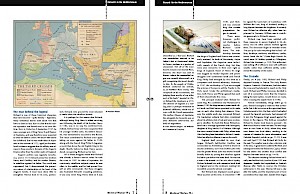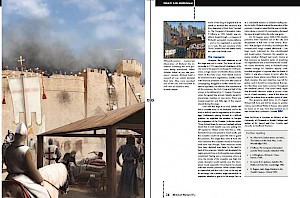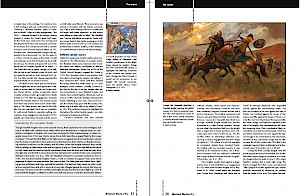MW IV-5
 We’re slowly nearing the end of September, which means that our next issue of Medieval Warfare will be back from the printers soon (around the 1st of October). The theme of Medieval Warfare IV-5 is Richard I in the Mediterranean, highlighting the English King’s exploits and successes in Sicily, Cyprus, and during his campaigns of the Third Crusade. A popular topic (popular enough to receive a big majority in our Volume IV poll; also see our Volume V poll, which is still open for voting), we’ve tried to offer a combination of the new and the familiar, and I for one am pleased with the result.
We’re slowly nearing the end of September, which means that our next issue of Medieval Warfare will be back from the printers soon (around the 1st of October). The theme of Medieval Warfare IV-5 is Richard I in the Mediterranean, highlighting the English King’s exploits and successes in Sicily, Cyprus, and during his campaigns of the Third Crusade. A popular topic (popular enough to receive a big majority in our Volume IV poll; also see our Volume V poll, which is still open for voting), we’ve tried to offer a combination of the new and the familiar, and I for one am pleased with the result.
 As always, the issue starts with an introduction, in this case written by our new contributor Luke Foddy. Starting with a short overview of military events in the Levant pre-1189, Luke then walks us through the stages which led to Richard I becoming King of England, as well as how he managed to get to the Holy Land safely. The articles that follow offer insight in the various stages of Richard’s journey. Gabriele Esposito talks about Richard’s first stop, Sicily, where he becomes involved in a power struggle, and which would cause him and King Philip of France to interfere in local politics; a major conflict between all parties (and thus a premature end of the Crusade) is only narrowly avoided. Stephen Bennett explains how, when Richard is once again on his way to the East, his fleet becomes scattered through a storm, with some vessels stranding on the island of Cyprus. While full-blown war was avoided in Sicily, the same could not be said of Cyprus, and Richard soon captured the island, providing him with a useful base of operations for his campaigns in the Levant.
As always, the issue starts with an introduction, in this case written by our new contributor Luke Foddy. Starting with a short overview of military events in the Levant pre-1189, Luke then walks us through the stages which led to Richard I becoming King of England, as well as how he managed to get to the Holy Land safely. The articles that follow offer insight in the various stages of Richard’s journey. Gabriele Esposito talks about Richard’s first stop, Sicily, where he becomes involved in a power struggle, and which would cause him and King Philip of France to interfere in local politics; a major conflict between all parties (and thus a premature end of the Crusade) is only narrowly avoided. Stephen Bennett explains how, when Richard is once again on his way to the East, his fleet becomes scattered through a storm, with some vessels stranding on the island of Cyprus. While full-blown war was avoided in Sicily, the same could not be said of Cyprus, and Richard soon captured the island, providing him with a useful base of operations for his campaigns in the Levant.

 His next stop is Acre, where a siege by Christian forces was getting nowhere. Richard’s charismatic leadership, and an influx of fresh and experiences troops, would bring about a Christian victory, though not without considerable problems, boh from the Muslims as well as from within the Christian camp. The end of the siege would witness one of Richard’s notorious acts, which is put in some perspective by Sean McGlynn. After the massacre, Richard, the remaining leader of the Crusade, then proceeds to win a major victory at the Battle of Arsuf, and later at the port of Jaffa, both discussed by Sidney Dean. Events in the Holy Land and back in France and England would cause the Crusade to end, and with Richard’s return to Europe, the theme events are at an end. However, aside from these chronological articles, the issue also contains a theme-related ‘The Source’ article, written by Gregory Liebau, which discusses the effectiveness of crusader equipment and tactics from the perspective of Muslim sources, the ones who were on the receiving end. In fact, Muslim authors provide us with a wealth of information, and Gregory has turned this into a great article. Moreover, in this issue’s The Castle section, Gareth Williams highlights some of Cyprus’ major castles, several of which were taken by Richard and his forces.
His next stop is Acre, where a siege by Christian forces was getting nowhere. Richard’s charismatic leadership, and an influx of fresh and experiences troops, would bring about a Christian victory, though not without considerable problems, boh from the Muslims as well as from within the Christian camp. The end of the siege would witness one of Richard’s notorious acts, which is put in some perspective by Sean McGlynn. After the massacre, Richard, the remaining leader of the Crusade, then proceeds to win a major victory at the Battle of Arsuf, and later at the port of Jaffa, both discussed by Sidney Dean. Events in the Holy Land and back in France and England would cause the Crusade to end, and with Richard’s return to Europe, the theme events are at an end. However, aside from these chronological articles, the issue also contains a theme-related ‘The Source’ article, written by Gregory Liebau, which discusses the effectiveness of crusader equipment and tactics from the perspective of Muslim sources, the ones who were on the receiving end. In fact, Muslim authors provide us with a wealth of information, and Gregory has turned this into a great article. Moreover, in this issue’s The Castle section, Gareth Williams highlights some of Cyprus’ major castles, several of which were taken by Richard and his forces.
While the theme-related articles take up most of the issue, we still found some room for a few non-theme articles. The first of these is written by Sean Manning, focusing on some strange types of weapons which may have been in use throughout the Middle Ages: the use of animals as vessels of incendiary devises. Graham Ashford once more shares his expertise about blacksmithing with our readers, this time explaining the difficulties of making a fourteenth-century arm harness. Last but not least, Brian Burfield has studied some of warfare’s invisible effects: the wounded mind. In this fascinating article, he provides an overview of several possible mental illnesses and their symptoms in the medieval period, and how these were treated by contemporaries.
The issue is now available for pre-order, which would save you 15 %, or you can go for the even cheaper option of buying a subscription. In case you missed it, the back issues of Volume I and II are now also available in digital form, for those of you with limited finances and/or limited room on the shelves.
